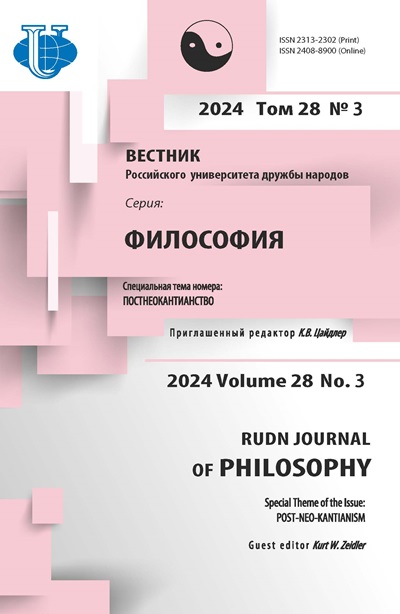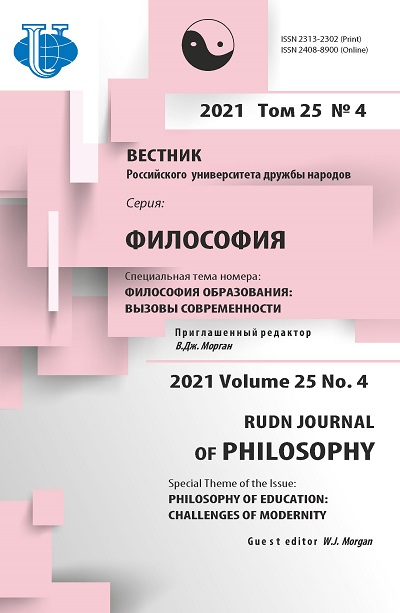Образование и телесность: вклад философии спорта
- Авторы: Циммерманн А.К.1
-
Учреждения:
- Университет Сан-Паулу
- Выпуск: Том 25, № 4 (2021): ФИЛОСОФИЯ ОБРАЗОВАНИЯ: ВЫЗОВЫ СОВРЕМЕННОСТИ
- Страницы: 602-612
- Раздел: ФИЛОСОФИЯ ОБРАЗОВАНИЯ: ВЫЗОВЫ СОВРЕМЕННОСТИ
- URL: https://journals.rudn.ru/philosophy/article/view/29692
- DOI: https://doi.org/10.22363/2313-2302-2021-25-4-602-612
Цитировать
Полный текст
Аннотация
Тематика телесности активно обсуждается в образовании. Автор задается целью очертить круг вопросов, которые могут быть рассмотрены в философии спорта, и которые могли бы способствовать плодотворному диалогу с философией образования. Отмечается, что философия образования может извлечь пользу из размышлений о телесности и человеческом движении, а именно из областей спорта и игр. В статье представлена философия спорта как область исследований, в которой рассматривается проблематика человеческих движений в спорте и играх. Выделяются элементы, которые не являются специфическими для указанных практик, и способствуют рефлексии по разным направлениям. Исследуется опыт телесности и диалогическое измерение человеческого движения на основе феноменологии М. Мерло-Понти; движение указывает на уникальный способ быть коммуникативным. В заключение автор рассматривает некоторые размышления об играх как опыте, который помогает задуматься об отношениях с другими людьми и окружающей средой. С данной точки зрения возможно определить ряд характеристик, значимых для понимания образования в сфере человеческого движения и игр, таких как опыт, диалог и выразительность. Размышления о человеческих движениях способны усилить роль телесности в образовании как коллективного опыта и признание выразительного потенциала тела в построении знаний.
Ключевые слова
Об авторах
Ана Кристина Циммерманн
Университет Сан-Паулу
Автор, ответственный за переписку.
Email: ana.zimmermann@usp.br
доцент
Brazil, São Paulo - SP, 05508-030, Av. Prof. Mello Moraes, 65Список литературы
- O’Loughlin M. Paying attention to bodies in education: theoretical resources and practical suggestions. Educational Philosophy and Theory. 1998;30(3):474-487.
- Stolz SA. Embodied Learning. Educational Philosophy and Theory. 2015; 47(5):275-297.
- Selchenok AK, Berest VA. Corporeality and the self: dissolving borders with technology. RUDN Journal of Philosophy. 2019;23(3):302-311.
- Marcel G. Being and having. Reino Unido, Read Books; 2007.
- Mauss M. Sociology and Psychology: Essays by Marcel Mauss. [Trans. Brewster B]. London: Routledge and Kegan Paul; 1979. Р. 95-135.
- Merleau-Ponty M. Phenomenology of perception. London: Routledge; 2002 (1962).
- Todd S, Hoveid MH, Langmann E. Educating the Senses: Explorations in Aesthetics, Embodiment and Sensory Pedagogy. Studies in Philosophy and Education. 2021;(40):243-248. https://doi.org/10.1007/s11217-021-09776-7
- Assmann H. Paradigmas educacionais e corporeidade. Piracicaba: Unimep; 1995.
- Buber M. Between man and man. London: Routledge; 2002 (1947).
- Torres CR. The Bloomsbury Companion to the Philosophy of Sport. London, Bloomsbury Publishing; 2014.
- Breivik G. From ‘philosophy of sport’ to ‘philosophies of sports’? History, identity and diversification of sport philosophy. Journal of the Philosophy of Sport. 2019;46(3):301-320. https://doi.org/10.1080/00948705.2019.1660882
- Huizinga J. Homo ludens: A study of the play-element in culture. London: Routledge &Kegan Paul; 1949.
- Caillois R. Man, play and games. New York: The Free Press of Glencoe; 1961.
- UN. United Nations. Sport for Development and Peace: Towards Achieving the Millennium Development Goals. Report from the United Nations Inter-Agency Task Force on Sport for Development and Peace. New York: UN; 2003.
- Zimmermann AC, Morgan WJ. Play, Sport, and Dialogue as Pathways to Peace? Peace Review. 2020;32(4):434-440. https://doi.org/10.1080/10402659.2020.1921396
- Renson R. Safeguarding Ludodiversity: The Role of a Sport Museum in the Promotion and Protection of Movement Culture. In: Saura SC, Zimmermann AC, editors. Traditional Games. São Paulo: Editora Laços; 2016. Р. 159-194.
- Polanyi M. The tacit dimension. London: Routledge and Kegan Paul; 1966.
- Irobi E. O que eles trouxeram consigo: carnaval e persistência da performance estética africana na diáspora. Projeto História. 2012;(44):273-293.
- Zimmermann AC, Morgan WJ. The possibilities and consequences of understanding play as dialogue. Sport, Ethics and Philosophy. 2011;5(1):46-62. https://doi.org/10.1080/17511321.2010.511250
- Badiou A. Handbook of inaesthetics. Stanford, California: Stanford University Press; 2005.
















